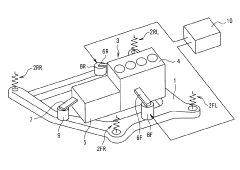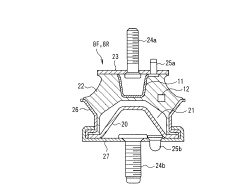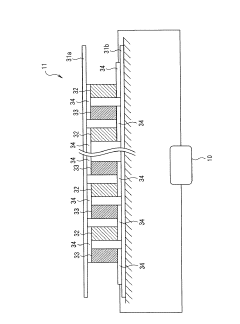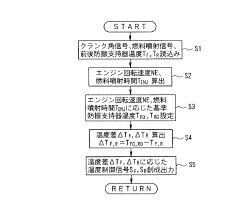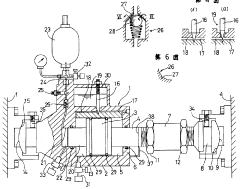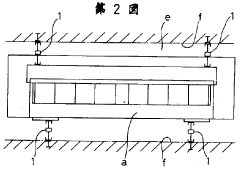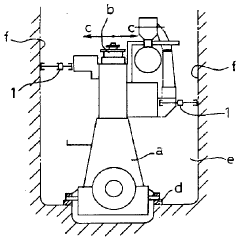How to Secure K24 Engine Against Vibration and Shock?
JUL 3, 20259 MIN READ
Generate Your Research Report Instantly with AI Agent
Patsnap Eureka helps you evaluate technical feasibility & market potential.
K24 Engine Vibration Challenges and Goals
The K24 engine, renowned for its performance and reliability, faces significant challenges in maintaining stability and longevity when subjected to vibration and shock. These forces, inherent in automotive applications, can lead to premature wear, reduced efficiency, and potential failure if not adequately addressed. The primary goal in securing the K24 engine against these detrimental effects is to enhance its overall durability and performance under various operating conditions.
Vibration in the K24 engine stems from multiple sources, including combustion processes, rotating components, and external factors such as road conditions. The engine's four-cylinder inline configuration, while efficient, can produce inherent imbalances that contribute to vibration. Additionally, the high-revving nature of the K24, particularly in performance applications, amplifies these challenges.
Shock events, whether from sudden impacts or rapid changes in load, pose a distinct threat to the engine's integrity. These can result in momentary misalignments, increased stress on bearings and mounts, and potential damage to critical components. The goal is to develop solutions that can absorb and dissipate these forces effectively, without compromising the engine's power output or responsiveness.
A key objective in addressing these issues is to implement advanced vibration dampening technologies. This includes refining engine mount designs to better isolate the powerplant from the vehicle's chassis, potentially incorporating active or semi-active systems that can adapt to varying conditions. Additionally, enhancing the internal balance of the engine through precision engineering and material selection is crucial.
For shock protection, the focus lies on developing more robust components capable of withstanding sudden impacts. This encompasses strengthening critical areas such as crankshaft bearings, connecting rods, and valve train components. Implementing advanced materials with superior shock-absorbing properties is also a primary consideration.
Another vital goal is to optimize the engine's electronic control systems to better manage power delivery and reduce vibration-inducing moments. This may involve fine-tuning engine mapping to smooth out power curves and implementing more sophisticated traction control systems that can preemptively mitigate shock loads.
Ultimately, the overarching aim is to create a holistic approach to vibration and shock mitigation in the K24 engine. This strategy should seamlessly integrate mechanical, material, and electronic solutions to ensure the engine maintains its performance characteristics while significantly improving its resilience to the harsh realities of automotive use.
Vibration in the K24 engine stems from multiple sources, including combustion processes, rotating components, and external factors such as road conditions. The engine's four-cylinder inline configuration, while efficient, can produce inherent imbalances that contribute to vibration. Additionally, the high-revving nature of the K24, particularly in performance applications, amplifies these challenges.
Shock events, whether from sudden impacts or rapid changes in load, pose a distinct threat to the engine's integrity. These can result in momentary misalignments, increased stress on bearings and mounts, and potential damage to critical components. The goal is to develop solutions that can absorb and dissipate these forces effectively, without compromising the engine's power output or responsiveness.
A key objective in addressing these issues is to implement advanced vibration dampening technologies. This includes refining engine mount designs to better isolate the powerplant from the vehicle's chassis, potentially incorporating active or semi-active systems that can adapt to varying conditions. Additionally, enhancing the internal balance of the engine through precision engineering and material selection is crucial.
For shock protection, the focus lies on developing more robust components capable of withstanding sudden impacts. This encompasses strengthening critical areas such as crankshaft bearings, connecting rods, and valve train components. Implementing advanced materials with superior shock-absorbing properties is also a primary consideration.
Another vital goal is to optimize the engine's electronic control systems to better manage power delivery and reduce vibration-inducing moments. This may involve fine-tuning engine mapping to smooth out power curves and implementing more sophisticated traction control systems that can preemptively mitigate shock loads.
Ultimately, the overarching aim is to create a holistic approach to vibration and shock mitigation in the K24 engine. This strategy should seamlessly integrate mechanical, material, and electronic solutions to ensure the engine maintains its performance characteristics while significantly improving its resilience to the harsh realities of automotive use.
Market Demand for Robust Engine Mounts
The market demand for robust engine mounts, particularly for the K24 engine, has been steadily increasing due to the growing emphasis on vehicle performance, safety, and longevity. As automotive manufacturers strive to meet stringent regulations and consumer expectations, the need for effective vibration and shock isolation solutions has become paramount.
In the passenger vehicle segment, where the K24 engine is commonly used, there is a significant demand for engine mounts that can withstand diverse driving conditions. Consumers are increasingly seeking vehicles that offer a smooth, quiet ride while maintaining high performance. This has led to a surge in demand for advanced engine mounting systems that can effectively dampen vibrations and absorb shocks, enhancing overall driving comfort and vehicle durability.
The commercial vehicle sector also presents a substantial market for robust engine mounts. Heavy-duty trucks and buses equipped with K24 engines or similar powertrains require superior vibration isolation to ensure longevity and reliability under demanding operating conditions. Fleet operators are willing to invest in high-quality engine mounts to reduce maintenance costs and vehicle downtime, driving the demand for innovative mounting solutions.
Off-road and performance vehicle markets contribute significantly to the demand for specialized engine mounts. These vehicles often subject their engines to extreme vibrations and shocks, necessitating highly durable and effective mounting systems. Enthusiasts and professional racers alike seek engine mounts that can maintain engine alignment and protect critical components under harsh conditions.
The aftermarket segment for K24 engine mounts has also seen considerable growth. As vehicles age, owners look to replace worn engine mounts with upgraded versions that offer better vibration control and longevity. This trend is particularly strong among performance enthusiasts who modify their vehicles for increased power output, requiring more robust engine mounting solutions to handle the additional stress.
Emerging markets in developing countries represent a growing opportunity for engine mount manufacturers. As these regions experience rapid motorization and infrastructure development, the demand for vehicles equipped with reliable engines like the K24 increases. This expansion drives the need for engine mounts capable of withstanding varied and often challenging road conditions.
Environmental concerns and fuel efficiency regulations have also influenced the market for engine mounts. Manufacturers are developing lighter yet more effective mounting systems that contribute to overall vehicle weight reduction without compromising vibration and shock absorption capabilities. This trend aligns with the automotive industry's push towards more fuel-efficient and environmentally friendly vehicles.
In the passenger vehicle segment, where the K24 engine is commonly used, there is a significant demand for engine mounts that can withstand diverse driving conditions. Consumers are increasingly seeking vehicles that offer a smooth, quiet ride while maintaining high performance. This has led to a surge in demand for advanced engine mounting systems that can effectively dampen vibrations and absorb shocks, enhancing overall driving comfort and vehicle durability.
The commercial vehicle sector also presents a substantial market for robust engine mounts. Heavy-duty trucks and buses equipped with K24 engines or similar powertrains require superior vibration isolation to ensure longevity and reliability under demanding operating conditions. Fleet operators are willing to invest in high-quality engine mounts to reduce maintenance costs and vehicle downtime, driving the demand for innovative mounting solutions.
Off-road and performance vehicle markets contribute significantly to the demand for specialized engine mounts. These vehicles often subject their engines to extreme vibrations and shocks, necessitating highly durable and effective mounting systems. Enthusiasts and professional racers alike seek engine mounts that can maintain engine alignment and protect critical components under harsh conditions.
The aftermarket segment for K24 engine mounts has also seen considerable growth. As vehicles age, owners look to replace worn engine mounts with upgraded versions that offer better vibration control and longevity. This trend is particularly strong among performance enthusiasts who modify their vehicles for increased power output, requiring more robust engine mounting solutions to handle the additional stress.
Emerging markets in developing countries represent a growing opportunity for engine mount manufacturers. As these regions experience rapid motorization and infrastructure development, the demand for vehicles equipped with reliable engines like the K24 increases. This expansion drives the need for engine mounts capable of withstanding varied and often challenging road conditions.
Environmental concerns and fuel efficiency regulations have also influenced the market for engine mounts. Manufacturers are developing lighter yet more effective mounting systems that contribute to overall vehicle weight reduction without compromising vibration and shock absorption capabilities. This trend aligns with the automotive industry's push towards more fuel-efficient and environmentally friendly vehicles.
Current State of K24 Engine Vibration Isolation
The K24 engine, renowned for its performance and reliability, currently employs several vibration isolation techniques to mitigate the effects of vibration and shock. The primary method involves the use of engine mounts, which are strategically placed to absorb and dampen vibrations. These mounts typically consist of rubber or elastomeric materials that provide a flexible connection between the engine and the vehicle's frame.
In addition to engine mounts, the K24 engine utilizes a balance shaft system to counteract inherent vibrations caused by the engine's four-cylinder configuration. This system consists of two counter-rotating shafts that generate forces opposite to the engine's natural vibrations, effectively canceling them out and resulting in smoother operation.
The current state of vibration isolation also includes the implementation of a dual-mass flywheel. This component helps to absorb torsional vibrations from the engine, reducing transmission of these vibrations to the drivetrain and improving overall NVH (Noise, Vibration, and Harshness) characteristics.
Furthermore, the K24 engine incorporates advanced electronic control systems that fine-tune engine operation to minimize vibration. These systems adjust ignition timing, fuel injection, and other parameters in real-time to optimize engine performance and reduce unwanted vibrations across various operating conditions.
Despite these measures, challenges remain in fully isolating the K24 engine from vibration and shock, particularly in high-performance applications or extreme operating environments. One persistent issue is the trade-off between rigid mounting for precise control and softer mounting for better vibration isolation. Engineers continue to seek innovative solutions to balance these competing demands.
Recent advancements in materials science have led to the development of new composite materials for engine mounts, offering improved vibration damping properties while maintaining durability. However, the integration of these materials into production vehicles is still in its early stages, with cost and long-term reliability being key considerations.
Another area of ongoing development is the use of active vibration control systems. These systems employ sensors to detect engine vibrations in real-time and use actuators to generate counter-vibrations, effectively canceling out unwanted motion. While promising, the complexity and cost of such systems have limited their widespread adoption in K24 engine applications thus far.
As vehicle electrification gains momentum, there is growing interest in hybrid powertrains that combine the K24 engine with electric motors. This configuration presents new challenges and opportunities for vibration isolation, as the integration of electric propulsion can both introduce new vibration sources and provide additional means for active vibration control.
In addition to engine mounts, the K24 engine utilizes a balance shaft system to counteract inherent vibrations caused by the engine's four-cylinder configuration. This system consists of two counter-rotating shafts that generate forces opposite to the engine's natural vibrations, effectively canceling them out and resulting in smoother operation.
The current state of vibration isolation also includes the implementation of a dual-mass flywheel. This component helps to absorb torsional vibrations from the engine, reducing transmission of these vibrations to the drivetrain and improving overall NVH (Noise, Vibration, and Harshness) characteristics.
Furthermore, the K24 engine incorporates advanced electronic control systems that fine-tune engine operation to minimize vibration. These systems adjust ignition timing, fuel injection, and other parameters in real-time to optimize engine performance and reduce unwanted vibrations across various operating conditions.
Despite these measures, challenges remain in fully isolating the K24 engine from vibration and shock, particularly in high-performance applications or extreme operating environments. One persistent issue is the trade-off between rigid mounting for precise control and softer mounting for better vibration isolation. Engineers continue to seek innovative solutions to balance these competing demands.
Recent advancements in materials science have led to the development of new composite materials for engine mounts, offering improved vibration damping properties while maintaining durability. However, the integration of these materials into production vehicles is still in its early stages, with cost and long-term reliability being key considerations.
Another area of ongoing development is the use of active vibration control systems. These systems employ sensors to detect engine vibrations in real-time and use actuators to generate counter-vibrations, effectively canceling out unwanted motion. While promising, the complexity and cost of such systems have limited their widespread adoption in K24 engine applications thus far.
As vehicle electrification gains momentum, there is growing interest in hybrid powertrains that combine the K24 engine with electric motors. This configuration presents new challenges and opportunities for vibration isolation, as the integration of electric propulsion can both introduce new vibration sources and provide additional means for active vibration control.
Existing Solutions for K24 Engine Vibration Control
01 Engine mounting systems for vibration reduction
Advanced mounting systems are designed to isolate the K24 engine from the vehicle chassis, reducing vibration transmission. These systems often incorporate elastomeric materials or hydraulic mounts that absorb and dampen engine vibrations, enhancing overall ride comfort and reducing structural stress on engine components.- Engine mounting systems for vibration reduction: Advanced engine mounting systems are designed to isolate and reduce vibrations from the K24 engine. These systems often incorporate elastomeric materials or hydraulic elements to absorb and dampen vibrations, preventing their transmission to the vehicle body. Such mounts can be strategically placed to counteract specific vibration frequencies and directions, enhancing overall engine stability and reducing noise.
- Shock-absorbing components for engine protection: Specialized shock-absorbing components are integrated into the K24 engine assembly to protect against sudden impacts and shocks. These may include reinforced engine brackets, impact-resistant materials in critical areas, and specially designed crankshaft dampers. Such components help maintain engine alignment and prevent damage from road irregularities or unexpected impacts.
- Active vibration control systems: Advanced electronic systems are employed to actively counteract engine vibrations in real-time. These systems use sensors to detect vibration patterns and generate opposing forces or signals to cancel out the vibrations. This technology can be particularly effective for addressing specific frequency ranges that are challenging to manage with passive systems alone.
- Optimized engine component design for vibration reduction: The design of K24 engine components is optimized to minimize inherent vibrations. This includes careful balancing of rotating assemblies, redesigned pistons and connecting rods for smoother operation, and enhanced crankshaft designs. Advanced materials and manufacturing techniques are used to create components that are both lightweight and rigid, reducing flexing and associated vibrations.
- Integrated chassis and powertrain vibration management: A holistic approach to vibration and shock resistance is implemented by considering the entire vehicle system. This involves optimizing the interaction between the engine, transmission, and chassis components. Techniques such as tuned mass dampers, strategic reinforcement of the vehicle structure, and advanced suspension systems work in concert with engine-specific measures to provide comprehensive vibration and shock control.
02 Shock-absorbing components for engine internals
Internal engine components are engineered with shock-resistant features to withstand the high-stress environment of the K24 engine. This includes reinforced pistons, connecting rods, and crankshafts designed to absorb and distribute shock loads, reducing wear and extending engine life while minimizing vibration transfer.Expand Specific Solutions03 Electronic vibration control systems
Advanced electronic systems are implemented to actively monitor and control engine vibration. These systems use sensors to detect vibration patterns and adjust engine parameters in real-time, such as ignition timing or fuel injection, to minimize vibration and maintain smooth operation across various engine speeds and loads.Expand Specific Solutions04 Balancing shaft technology
K24 engines may incorporate balancing shaft technology to counteract inherent engine vibrations. These shafts rotate at specific speeds and orientations to offset the natural vibrations produced by the engine's moving components, resulting in smoother operation and reduced overall engine vibration.Expand Specific Solutions05 Vibration-damping materials and coatings
Specialized materials and coatings are applied to various engine components to absorb and dissipate vibrations. These may include composite materials in engine covers, vibration-damping coatings on internal surfaces, or the use of advanced polymers in gaskets and seals to reduce the transmission of vibrations throughout the engine assembly.Expand Specific Solutions
Key Players in Engine Mount Manufacturing
The market for securing K24 engines against vibration and shock is in a growth phase, driven by increasing demand for high-performance engines in automotive and industrial applications. The global market size for engine vibration control systems is expected to expand significantly in the coming years. Technologically, solutions are evolving from basic dampeners to advanced active control systems. Key players like Nissan, Honda, and Toyota are investing heavily in R&D to develop innovative vibration mitigation technologies. Emerging companies such as Loncin Motor and Yanmar Power Technology are also making strides in this field, focusing on cost-effective solutions for smaller engines. The competition is intensifying as firms strive to balance performance, durability, and cost-effectiveness in their vibration control offerings.
Hyundai Motor Co., Ltd.
Technical Solution: Hyundai's strategy for securing the K24 engine against vibration and shock involves a multi-layered approach. The company has developed an advanced dynamic engine mounting system that uses electro-hydraulic mounts with variable damping characteristics[15]. This system adjusts in real-time based on engine speed, load, and vehicle dynamics. Hyundai has also implemented a balancer shaft module in the K24 engine to counteract second-order vibrations inherent in four-cylinder engines[17]. The company utilizes a proprietary noise, vibration, and harshness (NVH) simulation software to optimize engine design and component placement for minimal vibration transmission[19]. Additionally, Hyundai has developed a lightweight, high-rigidity engine cradle that isolates engine vibrations from the vehicle chassis while maintaining structural integrity[21].
Strengths: Comprehensive approach addressing both engine-generated and transmitted vibrations; integration of advanced simulation tools in the design process. Weaknesses: Potential for increased engine complexity and weight due to additional balancing components; reliance on sophisticated electronic control systems may increase maintenance requirements.
Robert Bosch GmbH
Technical Solution: Bosch has developed a suite of technologies to address vibration and shock in engines like the K24. Their solution includes an intelligent engine mount system that adapts to different driving conditions and engine loads. This system uses magnetorheological fluid mounts that can change stiffness in milliseconds based on electronic control signals[7]. Bosch has also created advanced sensors and control algorithms that work in conjunction with the engine management system to predict and mitigate vibrations before they occur[9]. Additionally, the company has developed lightweight, high-strength materials for engine components that help reduce overall vibration while maintaining structural integrity[11]. Bosch's approach also incorporates active vibration cancellation technology integrated into the vehicle's audio system to further reduce perceived engine vibration and noise[13].
Strengths: Highly adaptive and responsive system; integration with existing vehicle electronics for seamless operation. Weaknesses: Dependency on complex electronic systems may increase potential points of failure; higher initial cost compared to traditional passive systems.
Core Innovations in Shock Absorption for K24
Vibration isolation and supporting device
PatentInactiveJP2006170250A
Innovation
- The device includes an elastic member with temperature adjusting means that detects the vibration state of the engine and adjusts the elasticity by controlling the temperature of the elastic member using a thermoelectric element to match the engine's vibration mode.
Vibration preventing device for engine
PatentInactiveJP1983034251A
Innovation
- A vibration-damping device is strategically placed around the engine mounting seat, comprising a vibration isolating bed with a turnbuckle mechanism, spherical bearings, and hydraulic chambers to apply pre-load and counteract torsional and lateral vibrations, ensuring effective restraint and damping of engine body movements.
Material Advancements for Vibration Dampening
Recent advancements in material science have significantly contributed to improving vibration dampening capabilities for engines like the K24. These innovations focus on developing materials that can effectively absorb and dissipate vibrational energy, thereby enhancing engine performance and longevity.
One of the most promising developments is in the field of composite materials. Engineers have created new carbon fiber reinforced polymers (CFRPs) that offer superior vibration dampening properties while maintaining high strength-to-weight ratios. These materials can be strategically incorporated into engine mounts and support structures to isolate the K24 engine from harmful vibrations.
Nano-engineered materials have also shown great potential in vibration control. Researchers have developed nanocomposites that incorporate carbon nanotubes or graphene into polymer matrices. These materials exhibit exceptional energy absorption capabilities due to their unique molecular structure, making them ideal for use in critical engine components.
Another area of advancement is in the development of viscoelastic materials. These substances combine the properties of viscous fluids and elastic solids, allowing them to deform under stress and return to their original shape when the stress is removed. New formulations of viscoelastic polymers have been engineered specifically for automotive applications, offering improved temperature stability and durability.
Magnetorheological (MR) fluids represent a cutting-edge solution for adaptive vibration dampening. These smart materials change their viscosity in response to magnetic fields, allowing for real-time adjustment of dampening properties. When integrated into engine mounts, MR fluids can provide dynamic vibration control that adapts to varying engine conditions.
Ceramic matrix composites (CMCs) have also gained attention for their ability to withstand high temperatures and provide excellent vibration dampening. These materials combine ceramic fibers with a ceramic matrix, resulting in a lightweight yet robust structure that can effectively reduce engine vibrations even in extreme operating conditions.
Advancements in metal matrix composites (MMCs) have led to the development of materials that combine the strength of metals with the dampening properties of ceramics or polymers. These composites can be tailored to specific vibration frequencies, making them particularly effective for addressing the unique challenges posed by the K24 engine.
As research in material science continues to progress, we can expect even more innovative solutions for vibration dampening in engines. The integration of these advanced materials into K24 engine design and manufacturing processes will play a crucial role in enhancing its performance, reliability, and overall longevity in the face of vibration and shock challenges.
One of the most promising developments is in the field of composite materials. Engineers have created new carbon fiber reinforced polymers (CFRPs) that offer superior vibration dampening properties while maintaining high strength-to-weight ratios. These materials can be strategically incorporated into engine mounts and support structures to isolate the K24 engine from harmful vibrations.
Nano-engineered materials have also shown great potential in vibration control. Researchers have developed nanocomposites that incorporate carbon nanotubes or graphene into polymer matrices. These materials exhibit exceptional energy absorption capabilities due to their unique molecular structure, making them ideal for use in critical engine components.
Another area of advancement is in the development of viscoelastic materials. These substances combine the properties of viscous fluids and elastic solids, allowing them to deform under stress and return to their original shape when the stress is removed. New formulations of viscoelastic polymers have been engineered specifically for automotive applications, offering improved temperature stability and durability.
Magnetorheological (MR) fluids represent a cutting-edge solution for adaptive vibration dampening. These smart materials change their viscosity in response to magnetic fields, allowing for real-time adjustment of dampening properties. When integrated into engine mounts, MR fluids can provide dynamic vibration control that adapts to varying engine conditions.
Ceramic matrix composites (CMCs) have also gained attention for their ability to withstand high temperatures and provide excellent vibration dampening. These materials combine ceramic fibers with a ceramic matrix, resulting in a lightweight yet robust structure that can effectively reduce engine vibrations even in extreme operating conditions.
Advancements in metal matrix composites (MMCs) have led to the development of materials that combine the strength of metals with the dampening properties of ceramics or polymers. These composites can be tailored to specific vibration frequencies, making them particularly effective for addressing the unique challenges posed by the K24 engine.
As research in material science continues to progress, we can expect even more innovative solutions for vibration dampening in engines. The integration of these advanced materials into K24 engine design and manufacturing processes will play a crucial role in enhancing its performance, reliability, and overall longevity in the face of vibration and shock challenges.
Environmental Impact of Engine Mount Solutions
The environmental impact of engine mount solutions for securing the K24 engine against vibration and shock is a critical consideration in modern automotive design. Traditional engine mounts, often made from rubber and metal components, have long been the standard solution. However, these materials can have significant environmental drawbacks throughout their lifecycle.
Rubber production, a key component in conventional engine mounts, involves energy-intensive processes and the use of petrochemicals. The extraction and processing of these raw materials contribute to greenhouse gas emissions and potential environmental contamination. Additionally, the manufacturing of metal components for engine mounts requires substantial energy input and may result in the release of pollutants during the smelting and forming processes.
More environmentally friendly alternatives are emerging in the field of engine mount solutions. Advanced composite materials, such as carbon fiber-reinforced polymers, offer superior vibration dampening properties while being lighter and potentially more sustainable. These materials often require less energy to produce and can be engineered for improved recyclability at the end of their lifecycle.
Hydraulic engine mounts, which use fluid-filled chambers to absorb vibrations, present another option with potential environmental benefits. While they may contain synthetic fluids, their ability to provide adaptive damping can lead to improved engine efficiency and reduced fuel consumption, indirectly lowering vehicle emissions over time.
The disposal and recycling of engine mounts also play a crucial role in their overall environmental impact. Traditional rubber mounts can be challenging to recycle due to the bonding of different materials. However, newer designs are focusing on ease of disassembly and material separation, facilitating more effective recycling processes and reducing waste sent to landfills.
Innovations in biodegradable materials for engine mounts are also being explored. These materials aim to minimize the long-term environmental impact by breaking down naturally at the end of their useful life. While still in early stages of development, such solutions could significantly reduce the ecological footprint of engine mount components in the future.
The manufacturing processes for engine mounts are evolving to become more environmentally friendly. Techniques such as 3D printing and advanced molding processes can reduce material waste and energy consumption during production. Furthermore, localized manufacturing of engine mounts can decrease transportation-related emissions in the supply chain.
In conclusion, the environmental impact of engine mount solutions for the K24 engine encompasses a wide range of factors, from raw material extraction to end-of-life disposal. As automotive manufacturers strive for more sustainable practices, the development of eco-friendly engine mount technologies continues to be an important area of focus, balancing performance requirements with environmental responsibility.
Rubber production, a key component in conventional engine mounts, involves energy-intensive processes and the use of petrochemicals. The extraction and processing of these raw materials contribute to greenhouse gas emissions and potential environmental contamination. Additionally, the manufacturing of metal components for engine mounts requires substantial energy input and may result in the release of pollutants during the smelting and forming processes.
More environmentally friendly alternatives are emerging in the field of engine mount solutions. Advanced composite materials, such as carbon fiber-reinforced polymers, offer superior vibration dampening properties while being lighter and potentially more sustainable. These materials often require less energy to produce and can be engineered for improved recyclability at the end of their lifecycle.
Hydraulic engine mounts, which use fluid-filled chambers to absorb vibrations, present another option with potential environmental benefits. While they may contain synthetic fluids, their ability to provide adaptive damping can lead to improved engine efficiency and reduced fuel consumption, indirectly lowering vehicle emissions over time.
The disposal and recycling of engine mounts also play a crucial role in their overall environmental impact. Traditional rubber mounts can be challenging to recycle due to the bonding of different materials. However, newer designs are focusing on ease of disassembly and material separation, facilitating more effective recycling processes and reducing waste sent to landfills.
Innovations in biodegradable materials for engine mounts are also being explored. These materials aim to minimize the long-term environmental impact by breaking down naturally at the end of their useful life. While still in early stages of development, such solutions could significantly reduce the ecological footprint of engine mount components in the future.
The manufacturing processes for engine mounts are evolving to become more environmentally friendly. Techniques such as 3D printing and advanced molding processes can reduce material waste and energy consumption during production. Furthermore, localized manufacturing of engine mounts can decrease transportation-related emissions in the supply chain.
In conclusion, the environmental impact of engine mount solutions for the K24 engine encompasses a wide range of factors, from raw material extraction to end-of-life disposal. As automotive manufacturers strive for more sustainable practices, the development of eco-friendly engine mount technologies continues to be an important area of focus, balancing performance requirements with environmental responsibility.
Unlock deeper insights with Patsnap Eureka Quick Research — get a full tech report to explore trends and direct your research. Try now!
Generate Your Research Report Instantly with AI Agent
Supercharge your innovation with Patsnap Eureka AI Agent Platform!
